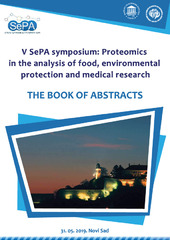| dc.creator | Mihailović, Jelena | |
| dc.creator | Prodić, Ivana | |
| dc.creator | Smiljanić, Katarina | |
| dc.creator | Ćirković-Veličković, Tanja | |
| dc.date.accessioned | 2023-10-09T13:24:31Z | |
| dc.date.available | 2023-10-09T13:24:31Z | |
| dc.date.issued | 2019 | |
| dc.identifier.isbn | 978-86-7031-511-2 | |
| dc.identifier.uri | http://intor.torlakinstitut.com/handle/123456789/770 | |
| dc.description.abstract | Introduction. Peanut allergy affects a large portion of world population causing reactions rangingfrom mild to severe. Major peanut allergen IgE epitopes are well characterized but little is knownabout their post-translational modifications (PTM) and how they are affected by thermaltreatment. PTM profile may differ between raw and thermally treated peanut, which could affectits allergic potential depending on type, size and position of modifications.Objective. Our aim was to analyse and compare PTM profiles of 4 major peanut allergens - Ara h 1,Ara h 2, Ara h 3 and Ara h 6, as well as their amounts in raw and roasted samples using bottom-upproteomics methods.Methodology. Full peanut protein extracts (both thermally treated and non-treated) were digestedin gel and in solution, and analysed by a Top10 nLC-MS/MS method by LTQ Orbitrap XL (ThermoFisher Scientific Inc., Germany). Within the extracts major allergens - Ara h 1, Ara h 2, Ara h 3 andAra h 6 were identified, label free quantified (LFQ) and searched for PTMs by Peaks X software(Bioinformatics solutions Inc.I, Canada). Epitope sequences were acquired from the ImmuneEpitope Database (IEDB www.iedb.org).Main findings. LFQ results show that there is no significant change in the amountsof any of thestudied allergens between raw and roasted extracts.Out of the 4 allergens Ara h 6 is modified in thehighest portion, with respect to the protein size: 15% and 12% of its positions are modified in rawand roasted sample, respectively. Total of 21 modifications were quantified between the twopreparations, with oxidation (M), methylation (K,R) and dethiomethylation affecting the largestnumber of peptides.Conclusions. Peanut allergen epitopes are indeed carriers of PTMs that differ in pattern andquantity between treated and non-treated extracts. The in silico discovered PTMs could affectprotein digestibility and allergenicity. Further investigation is necessary in order to fully understandthe impact protein modifications could have on their allergenic potential. | sr |
| dc.language.iso | en | sr |
| dc.publisher | Serbian Proteomic Association - SePA | sr |
| dc.relation | info:eu-repo/grantAgreement/MESTD/Basic Research (BR or ON)/172024/RS// | sr |
| dc.relation | Ghent University Global Campus, Belgian Special Research Fund BOF StG No. 01N01718. | sr |
| dc.relation | info:eu-repo/grantAgreement/EC/H2020/810752/EU// | sr |
| dc.rights | openAccess | sr |
| dc.rights.uri | https://creativecommons.org/licenses/by/4.0/ | |
| dc.source | Book of Abstracts - V SePa Simposium: Proteomics in the analysis of food, environmental protection and medical research, Novi Sad 2019 | sr |
| dc.subject | mass spectrometry based bottom-up proteomics | sr |
| dc.subject | PTMs | sr |
| dc.subject | LFQ | sr |
| dc.subject | relative quantification | sr |
| dc.subject | allergens | sr |
| dc.subject | peanut | sr |
| dc.title | Comparative study of raw and thermally treated peanut major allergen post- translational modifications (PTMs) | sr |
| dc.type | conferenceObject | sr |
| dc.rights.license | BY | sr |
| dc.citation.spage | 16/L10 | |
| dc.identifier.fulltext | http://intor.torlakinstitut.com/bitstream/id/1730/Comparative_study_of_raw_pub_2019.pdf | |
| dc.identifier.rcub | https://hdl.handle.net/21.15107/rcub_intor_770 | |
| dc.type.version | publishedVersion | sr |

